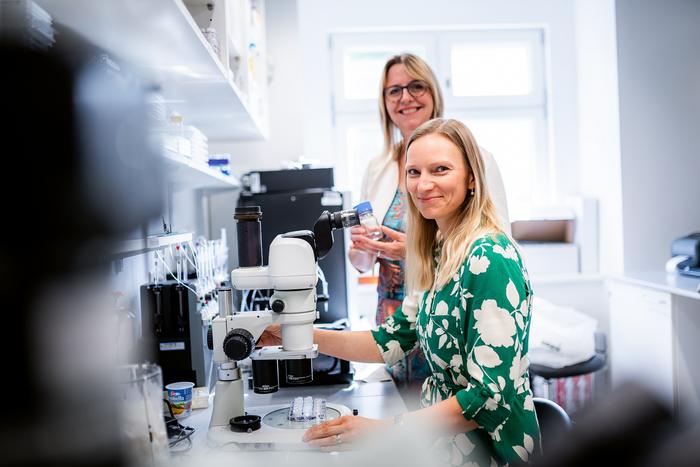Researchers from the Institute of Organic Chemistry and Biochemistry of the Czech Academy of Sciences, in cooperation with colleagues from the Faculty of Tropical AgriScience of the Czech University of Life Sciences in Prague, are unravelling the mysteries of the life of termites. Colonies of the species Neocapritermes taracua boast a unique type of defence, which is provided by worker termites at the end of their lives. When attacked, they sacrifice themselves by setting off an explosive chemical reaction, the result of which is a toxic liquid that immobilizes and poisons their adversary. Dr Jana Škerlová and her colleagues from the scientific group of Assoc. Prof. Pavlína Maloy Řezáčová has been able to describe in detail the mechanism by which the mysterious enzyme which termites carry on their backs works. Her latest article on the topic has been published in the scientific journal Structure.

Credit: Photo: Tomáš Belloň/IOCB Prague
Researchers from the Institute of Organic Chemistry and Biochemistry of the Czech Academy of Sciences, in cooperation with colleagues from the Faculty of Tropical AgriScience of the Czech University of Life Sciences in Prague, are unravelling the mysteries of the life of termites. Colonies of the species Neocapritermes taracua boast a unique type of defence, which is provided by worker termites at the end of their lives. When attacked, they sacrifice themselves by setting off an explosive chemical reaction, the result of which is a toxic liquid that immobilizes and poisons their adversary. Dr Jana Škerlová and her colleagues from the scientific group of Assoc. Prof. Pavlína Maloy Řezáčová has been able to describe in detail the mechanism by which the mysterious enzyme which termites carry on their backs works. Her latest article on the topic has been published in the scientific journal Structure.
The termite species Neocapritermes taracua has evolved a peculiar defence mechanism that is unparalleled in the insect world. Worker termites play a key role in it. Over their lifetime, they gradually amass a particular enzyme, blue laccase BP76, in special pockets on their backs. When their colony finds itself in danger, older individuals tear this ‘rucksack’ apart. The enzyme is then almost immediately mixed with another substance stored in the termite body, which up to this point is relatively harmless, creating a sticky liquid containing highly poisonous benzoquinones. Although this kills the kamikaze termite itself, it also immobilizes or kills the attacker.
How this potentially explosive enzyme stays active in a solid state on the backs of insects was a true scientific riddle. Scientists from the Structural Biology research group at IOCB Prague have solved the puzzle with the help of X-ray crystallography. Jana Škerlová was intrigued by the fact that the blue laccase borne by termites contains an unusually strong bond between two amino acids—which are the building blocks of proteins—near the active site of the enzyme, to which the target molecule binds and where it reacts. She explains: ‘Unravelling the three-dimensional structure of laccase BP76 revealed that this enzyme uses a variety of stabilization strategies, which make it not only highly durable, but also fully functional even in the harsh conditions of tropical rainforests.’ Due to its unique structure, laccase BP76 not only remains intact, but also active even though it rests on the back of a termite over the course of its entire life. This is crucial for the enzyme’s role in the defence mechanism, because in the event of an attack on the colony, the reaction must be immediate.
Termites of the species Neocapritermes taracua can live a whole lifetime with this suicidal load. Young individuals, which are still capable of doing a lot of work for their colony, carry only small amounts of the enzyme in their back pockets. The blue ‘rucksack’, in which the explosive material accumulates, grows larger over time as the insect loses strength. Its last service to the termite mound is that it is prepared to sacrifice itself for the good of the colony.
The fact that Neocapritermes taracua termites have solid packets of an active enzyme tucked into pockets of their raincoats, which they do not hesitate to use as a weapon in an emergency, was first observed by researchers in French Guiana some years ago. That research, published in the journal Science, also bears the IOCB Prague seal. One of the researchers that collaborated on the seminal study was Professor Jan Šobotník, who is also a co-author of the present paper, currently works at the Faculty of Tropical AgriScience of the Czech University of Life Sciences.
‘Our discovery is an excellent illustration of the irreplaceable role of structural biology. Just as knowledge about individual components of an instrument sheds light on how it works, knowing the three-dimensional structure (i.e. the positions of individual atoms) of a molecule helps us understand a biological process. In this case it is a unique defence mechanism of termites,’ emphasizes Pavlína Řezáčová, head of the laboratory from which the research originates.
Original article: Škerlová, J.; Brynda, J.; Šobotník, J.; Zákopčaník, M.; Novák, P.; Bourguignon, T.; Sillam-Dussès, D.; Řezáčová, P. Crystal structure of blue laccase BP76, a unique termite suicidal defense weapon. Structure 2024.
IOCB Prague / The Institute of Organic Chemistry and Biochemistry of the Czech Academy of Sciences (www.uochb.cz) is a leading internationally recognized scientific institution whose primary mission is the pursuit of basic research in chemical biology and medicinal chemistry, organic and materials chemistry, chemistry of natural substances, biochemistry and molecular biology, physical chemistry, theoretical chemistry, and analytical chemistry. An integral part of the IOCB Prague’s mission is the implementation of the results of basic research in practice. Emphasis on interdisciplinary research gives rise to a wide range of applications in medicine, pharmacy, and other fields.
Journal
Structure
Method of Research
Experimental study
Article Title
Crystal structure of blue laccase BP76, a unique termite suicidal defense weapon
Article Publication Date
15-Aug-2024



